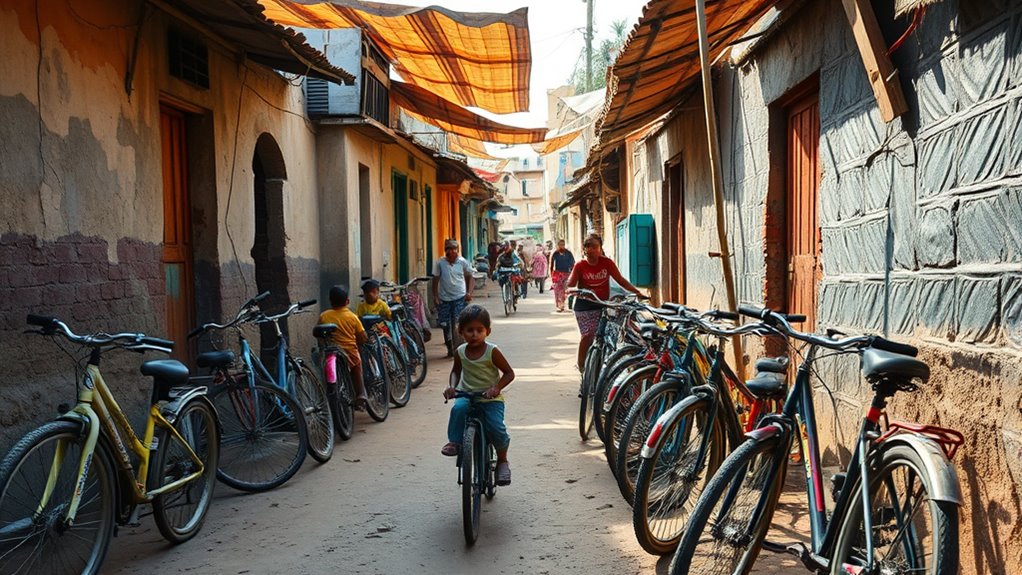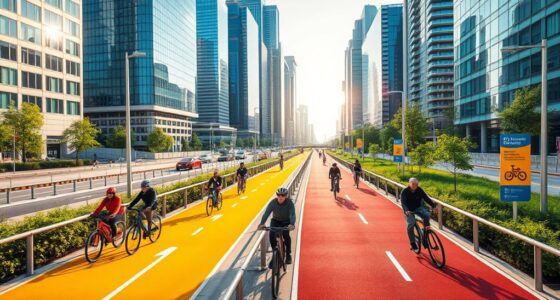Cycling in low-income regions boosts mobility by providing an affordable and accessible transport option, helping you connect to markets, schools, and workplaces easily. Developing safe bike lanes and promoting safety awareness with gear and education can considerably reduce accidents. Building a supportive cycling culture not only improves health but also lessens traffic congestion and pollution. If you want to explore how infrastructure and community efforts can create lasting change, there’s much more to discover below.
Key Takeaways
- Cycling improves mobility and connects communities in low-income regions, offering an affordable transportation alternative.
- Developing safe, well-connected bike infrastructure encourages cycling adoption and enhances urban mobility.
- Safety awareness campaigns and community engagement are vital to reduce accidents and promote responsible cycling.
- Building a safety and awareness culture fosters confidence among cyclists and supports sustainable transportation practices.
- Integrated infrastructure and safety initiatives improve access to opportunities, healthcare, and education, boosting community well-being.

Have you ever considered how cycling can transform transportation in low-income regions? It’s a simple, affordable solution that can substantially improve mobility, reduce congestion, and promote healthier communities. But for cycling to truly make an impact, urban infrastructure needs to adapt, making bike routes safe, accessible, and integrated into the city’s layout. Without proper pathways, designated bike lanes, and clear signage, cyclists face dangers that discourage their use and undermine the benefits cycling can offer. Investing in urban infrastructure isn’t just about adding bike lanes; it’s about creating a network that connects neighborhoods, markets, schools, and workplaces seamlessly. When cycling infrastructure is thoughtfully developed, it encourages more people to choose bikes over unreliable or costly public transportation or motorized vehicles, especially in regions where affordability is a concern.
Developing safe, connected cycling infrastructure encourages affordable, healthy transportation in low-income communities.
However, infrastructure alone isn’t enough. You also need to promote safety awareness among cyclists and pedestrians alike. Many low-income regions experience a lack of safety education, leading to accidents and discouragement from cycling. Raising awareness involves community engagement, workshops, and campaigns that teach proper riding techniques, traffic rules, and the importance of visibility. When people understand how to navigate urban streets safely and recognize the responsibilities of all road users, cycling becomes a more attractive and secure option. Safety awareness initiatives can also include distributing reflective gear, helmets, and providing information on the safest routes, further lowering the risk of accidents.
Building a culture of safety and awareness helps break down misconceptions that cycling is dangerous, especially in areas with chaotic traffic patterns or poorly maintained roads. It’s essential to involve local leaders, schools, and community organizations in spreading these messages, ensuring that safety becomes a shared value. When people feel confident in their ability to cycle safely, they’re more likely to adopt it as a regular mode of transportation. This, in turn, reduces reliance on motorbikes, cars, and informal transport options, easing traffic congestion and pollution.
Ultimately, successful cycling mobility in low-income regions hinges on a dual approach: developing robust urban infrastructure and fostering safety awareness. Together, these efforts can transform streets into safer, more inclusive spaces that empower residents to move freely and affordably. As cycling gains ground, it can help build resilient communities where everyone has better access to opportunities, healthcare, and education—making low-income areas more sustainable and vibrant in the long run. Additionally, investing in high-quality projectors with features like wide color gamuts and high contrast ratios can enhance the visual experience, much like creating a comprehensive cycling network improves mobility and community well-being.
Frequently Asked Questions
How Do Cycling Initiatives Impact Local Economies in Low-Income Areas?
Cycling initiatives boost local economies by encouraging urban development and supporting small businesses. When you promote cycling, you reduce traffic congestion and pollution, enhancing environmental sustainability. This attracts more visitors and residents, creating jobs and increasing spending in shops and markets. As you invest in cycling infrastructure, you foster a healthier, more connected community, which further stimulates economic growth and sustainable urban development in low-income areas.
What Safety Measures Are Most Effective for Low-Income Cyclists?
Think of safety as your shield on the road. Wearing proper protective gear, like helmets and reflective clothing, is your first line of defense. Community workshops teach you essential skills and raise awareness about safe cycling practices. These measures help low-income cyclists stay protected, confident, and visible. By prioritizing protective gear and participating in local workshops, you create a safer environment where everyone can ride with peace of mind and freedom.
How Can Governments Fund Cycling Infrastructure in Impoverished Regions?
You can fund cycling infrastructure in impoverished regions by seeking private partnerships and international grants. These sources provide essential financial support and technical expertise, making projects feasible. Engage local communities and stakeholders to demonstrate the benefits, encouraging investment. Governments should actively pursue collaborations with NGOs and international organizations, ensuring transparent allocation of funds. This approach accelerates infrastructure development, improves safety, and promotes sustainable mobility for low-income populations.
What Cultural Barriers Exist to Adopting Cycling in These Communities?
You might find that gender norms often discourage women from cycling, fearing social judgment or safety concerns. Religious beliefs can also influence attitudes, with some communities viewing cycling as inappropriate or incompatible with cultural practices. These barriers limit adoption, as many feel pressured to conform to traditional roles and expectations. Overcoming these challenges requires respectful community engagement and culturally sensitive awareness campaigns to promote inclusive cycling opportunities.
How Does Cycling Influence Health Outcomes in Low-Income Populations?
Cycling boosts health outcomes by encouraging physical activity, reducing obesity, and improving cardiovascular health. When you engage with your community and support better urban planning that prioritizes cycling infrastructure, you make it easier for everyone to ride safely and regularly. This creates a positive cycle—literally—where increased cycling leads to healthier lifestyles and more active communities, ultimately reducing health disparities in low-income populations.
Conclusion
Just as the phoenix rises from its ashes, embracing cycling in low-income regions can spark renewal and hope. By investing in affordable bikes and infrastructure, you empower communities to break free from isolation and poverty. Remember, the bicycle isn’t just a mode of transport; it’s a symbol of resilience and change. Together, you can turn the wheels of progress, proving that even in hardship, every journey forward begins with a single pedal stroke.
















